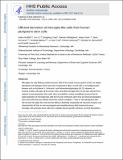Efficient derivation of microglia-like cells from human pluripotent stem cells
Author(s)
Muffat, Julien; Li, Yun; Yuan, Bingbing; Mitalipova, Maisam; Omer, Attya; Bakiasi, Grisilda; Aubourg, Patrick; Ransohoff, Richard M; Corcoran, Sean R.; Tsai, Li-Huei; Jaenisch, Rudolf; ... Show more Show less
Downloadnihms813405.pdf (2.163Mb)
OPEN_ACCESS_POLICY
Open Access Policy
Creative Commons Attribution-Noncommercial-Share Alike
Terms of use
Metadata
Show full item recordAbstract
Microglia, the only lifelong resident immune cells of the central nervous system (CNS), are highly specialized macrophages that have been recognized to have a crucial role in neurodegenerative diseases such as Alzheimer's, Parkinson's and adrenoleukodystrophy (ALD). However, in contrast to other cell types of the human CNS, bona fide microglia have not yet been derived from cultured human pluripotent stem cells. Here we establish a robust and efficient protocol for the rapid production of microglia-like cells from human (h) embryonic stem (ES) and induced pluripotent stem (iPS) cells that uses defined serum-free culture conditions. These in vitro pluripotent stem cell-derived microglia-like cells (termed pMGLs) faithfully recapitulate the expected ontogeny and characteristics of their in vivo counterparts, and they resemble primary fetal human and mouse microglia. We generated these cells from multiple disease-specific cell lines and find that pMGLs derived from an hES model of Rett syndrome are smaller than their isogenic controls. We further describe a platform to study the integration and live behavior of pMGLs in organotypic 3D cultures. This modular differentiation system allows for the study of microglia in highly defined conditions as they mature in response to developmentally relevant cues, and it provides a framework in which to study the long-term interactions of microglia residing in a tissue-like environment.
Date issued
2016-09Department
Massachusetts Institute of Technology. Department of Biology; Massachusetts Institute of Technology. Department of Brain and Cognitive Sciences; Picower Institute for Learning and MemoryJournal
Nature Medicine
Publisher
Nature Publishing Group
Citation
Muffat, Julien, et al. “Efficient Derivation of Microglia-Like Cells from Human Pluripotent Stem Cells.” Nature Medicine 22, 11 (September 2016): 1358–1367 © 2016 Nature America, Inc, part of Springer Nature
Version: Author's final manuscript
ISSN
1078-8956
1546-170X